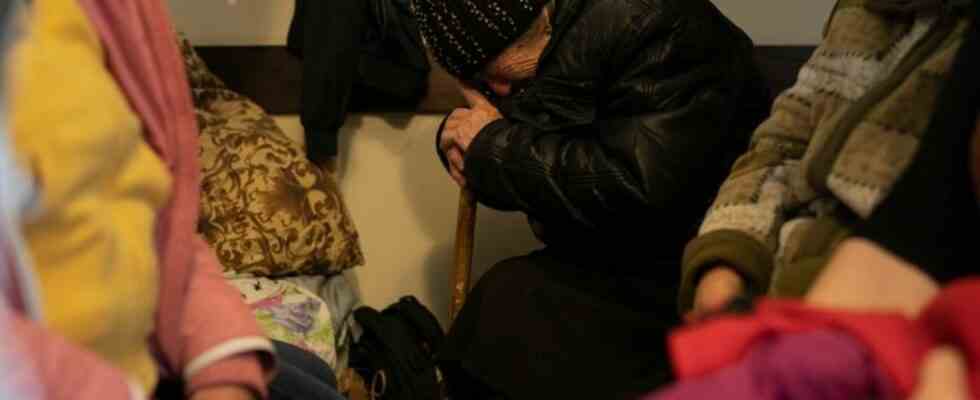Russian troops continue bombing cities in Ukraine. It is unclear whether this is actually the expected major offensive in the Donbass. The developments at a glance.
Russian troops are advancing in Ukraine, but the feared major offensive could be yet to come. On Thursday night there were reports of Russian shelling from several Ukrainian cities.
The Russians have been attacking along the entire front in the Donetsk, Luhansk and Kharkiv regions since Tuesday, Secretary of the Ukrainian Security Council Oleksiy Danilov said in a radio interview. However, these are probably only “test attacks”.
However, according to Ukrainian sources, most of Luhansk is already under Russian control. According to estimates by the leader of the Russian republic of Chechnya, the Azovstal steelworks in the embattled port city of Mariupol will also fall to the Russians today.
After long pleas for more and heavy weapons, the Ukrainian President now sees more understanding from partner countries. They now understand what weapons Ukraine needs, and if possible now, said Volodymyr Zelenskyy in his video message every evening. Germany, too, had long been accused of hesitation.
Last ultimatum for people in Mariupol?
According to Russian information, around 2,500 Ukrainian fighters and foreign mercenaries are still in the Azovstal steel plant. According to Ukrainian reports, around 1,000 civilians are said to have sought protection there. “Today before or after lunch, Azovstal will be completely under the control of Russian forces,” said Chechen leader Ramzan Kadyrov, whose units are fighting in Ukraine. The Ukrainian fighters remaining in the steelworks still have the opportunity to surrender in the morning. If they do so, he is certain that the Russian leadership will make “the right decision”.
On Wednesday evening, during talks with Russia, two representatives of the Ukrainian delegation declared their willingness to come to Mariupol to negotiate the evacuation of militants and civilians from the steelworks. The commander of the remaining marines had previously asked for his fighters to be evacuated to a third country. According to Ukrainian sources, a rescue of civilians failed again on Wednesday.
Luhansk largely under Russian control
After the withdrawal of Ukrainian troops from the small town of Krimenna, Russian units now controlled 80 percent of the Luhansk region, the region’s governor, Serhiy Hajday, announced on Telegram on Wednesday evening.
The cities of Rubishne and Popasna in Luhansk are now “partially” under Russian control. There has been intense fighting over this for weeks. The shelling increased here too. At the beginning of the Russian war of aggression around eight weeks ago, the separatists of the Luhansk “People’s Republic” still had around 30 percent of the region under their control.
Uncertainty about the beginning of the Russian major offensive
However, it was unclear whether the expected major offensive by the Russians had already begun with the fighting in the east of the country. Ukrainian President Volodymyr Zelenskyy had already declared on Monday evening that “the battle for Donbass” had begun. However, according to the Secretary of his Security Council, that is not the case yet. But it is only a matter of time.
The US Department of Defense also said on Tuesday that it saw the latest Russian attacks only as a sign of a major offensive by Moscow. The secretary of the Security Council of Ukraine warned against thinking that the fighting for Donbass will be the last battle. “I wouldn’t be so optimistic, there could be a lot of different things ahead of us,” explained Danilov.
More mass graves in front of Kyiv
Meanwhile, two more mass graves have been discovered in the Kiev suburb of Borodyanka, according to Ukrainian sources. It contained a total of nine bodies of civilians, men and women, said Andriy Nebitov from the police in the capital region on Thursday night on Facebook. Some of them showed signs of torture.
Borodyanka is one of the most heavily damaged cities in the capital region. Atrocities by the Russian units that have meanwhile withdrawn were reported from the city. The information could not be independently verified.
Zelenskyj: Partners understand the need for weapons
After days of urgent pleas for more and heavy weapons, Zelenskyy sees more understanding among Ukraine’s partner countries. He could say with “cautious optimism” that Kiev’s partners “have become more aware of our needs,” said Selenskyj in his video message every evening on Thursday night.
Germany, especially Chancellor Olaf Scholz (SPD), had been accused of hesitation in delivering heavy weapons for days. Scholz then presented the further strategy on Tuesday evening: According to this, the federal government finances direct arms deliveries from industry to Ukraine.
Since the beginning of the war, Germany has received a good 2,500 anti-aircraft missiles, 900 Panzerfausts with 3,000 rounds of ammunition, 100 machine guns and 15 Bunkerfausts with 50 rockets. In addition, 100,000 hand grenades, 2000 mines, around 5300 explosive charges and more than 16 million rounds of ammunition of various calibers for handguns, the German press agency learned from Ukrainian government circles. Heavy weapons such as tanks or artillery are not on the list.
That will be important on Thursday
US President Joe Biden wants to comment on Russia and Ukraine. Meanwhile, in Estonia, German Foreign Minister Annalena Baerbock is consulting with the political leadership of the Baltic state about the consequences of the Russian war of aggression against Ukraine.
Talks by Baerbock with her colleague Eva-Maria Liimets and a meeting with Prime Minister Kaja Kallas are planned in Tallinn. An international meeting in support of Ukraine will be held in Washington on the same day with the participation of World Bank head David Malpass and IMF head Georgieva.

